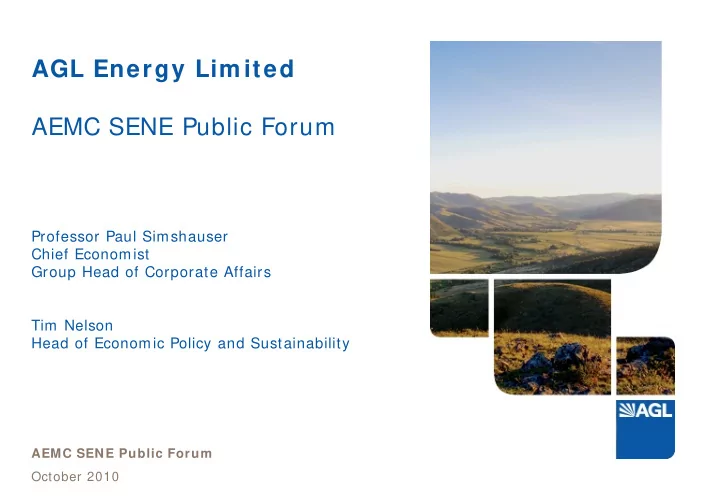

AGL Energy Lim ited AEMC SENE Public Forum Professor Paul Simshauser Chief Economist Group Head of Corporate Affairs Tim Nelson Head of Economic Policy and Sustainability AEMC SENE Public Forum October 2010
2 AGL partially supports Option 4 › Option 4 is the best option suggested in the Options paper › Signed connection agreement means investors, rather than consumers, take on the financial risk associated with projects › Economic incremental capacity can be analysed within the RIT-T process which analyses costs and benefits of alternative options Avoids introducing a 3 rd & special class of transmission » » Ensures consumers are not exposed to risks associated with a proposal not being the best option from a cost-benefit perspective; » Enables time to establish whether in fact a market failure actually exists (i.e. investment coordination) » AEMC SENE Public Forum » October 2010
3 Public policy merit of SENE › There is no sound public policy reason for introduction of SENE » SENE is directionally at odds with more than a decade of energy market reform; a shift back to centralised planning needs to demonstrate that the costs of central planning (and there are costs) outweigh the costs of market failure » It is easy to demonstrate that a 300MW line is more efficient than 3 x 100MW lines, but » no market failure (i.e. industry coordination) has been demonstrated, and the rules that once prevented industry coordination have been remedied » There is no precedent in other industries (e.g. gas pipelines, high-rise buildings) › Modelling now exists that shows that societal welfare is higher where renewables are delivered closer to the existing grid › And the RIT-T already applies to network extensions » AEMC SENE Public Forum » October 2010
4 AGL agrees with the criteria for assessment › Efficient investment in electricity services » The market is best placed to determine which investment is efficient » AEMO, AER and NSPs know significantly less about optimal locations for merchant investment than market participants because of real world investment constraints & private information. The NEM is a prime example of where good economic theory and the harsh realities of real-world corporate finance quite simply collide › Efficient risk allocation mechanisms » The most elegant outcome of the NEM reform was shifting the cost of planning failure from customers to shareholders; SENE proposal absolves investors and NSPs of financial risk » SENE involves the privatisation of profits and socialisation of losses associated with a decision which customers have no control over » AEMC SENE Public Forum » October 2010
5 Energy investment expertise › To actually bank a merchant project to financial completion, it requires the coordination and collective skills of: » Investment banks » Corporate institutional or project finance banks » Merchant utility energy trading desks » Legal, Taxation and Engineering firms » Power development business › AEMO, NSPs and the AER do not have (nor should they need) this expertise » AEMC SENE Public Forum » October 2010
Investment hit rate indicates picking winners 6 is impossible – that’s why we deregulated Technology Proposed Com pleted Project Projects Projects Conversion Rate Coal 19 7 37% CCGT 16 6 38% OCGT 68 22 32% Renewables 76 27 36% NEM 179 62 35% Source: Simshauser (2010), Capital adequacy, ETS and investment uncertainty in the Australian power market, Electricity Journal, Vol 23. No.1. » AEMC SENE Public Forum » October 2010
Recommend
More recommend